#tour of 1824/1825
Text
24 Days of La Fayette - Day 3
Have you ever wondered, why the National Guard is named the National Guard? If so, then I have a painting for you:

Lafayette and the National Guard, a National Guard Heritage Painting by Ken Riley, courtesy the National Guard Bureau (12/03/2023).
La Fayette’s Tour through America in 1824 and 1825 was the event of its time. People turned out by the thousands whenever La Fayette visited and even after over a year the people were still as enthusiastic as on the first day. It were not only civilians that lined the streets to greet La Fayette but also military personal. During La Fayette’s stay in New York, immediately prior to his departure for France, a company of militia men, the 11th New York Artillery, later the 7th regiment, lined the street for La Fayette. The unit had named themselves the National Guard in memory of La Fayette’s National Guard during the French Revolution. La Fayette was apparently so touched when seeing these men, that he halted his carriage and shook the hand of every single soldier. This moment is depicted in the painting.
I could sadly find no reference to this encounter in Auguste Levasseur’s book, but we do know that by 1903 the name National Guard had become so popular that it was adopted nationwide.
The painting was done by Kenneth Pauling Riley, in, I assume 2004. Riley could at that point already look back onto a long career. He had become a war artist in World War II and after the war, President John F. Kennedy purchased on of his portraits, The Whites in their Eyes about the Battle of Bunker Hill, for the White House. Riley died in 2015.
#24 days of la fayette#marquis de lafayette#french history#la fayette#american history#history#kenneth pauling riley#2004#national guard#auguste levasseur#french revolution#triumphant tour#tour of 1824/1825
82 notes
·
View notes
Photo

𝗜𝗥𝗔 𝗔𝗟𝗗𝗥𝗜𝗗𝗚𝗘 (1807-1867)
𝗜𝗿𝗮 𝗙𝗿𝗲𝗱𝗲𝗿𝗶𝗰𝗸 𝗔𝗹𝗱𝗿𝗶𝗱𝗴𝗲 𝘄𝗮𝘀 𝘁𝗵𝗲 𝗳𝗶𝗿𝘀𝘁 𝗔𝗳𝗿𝗶𝗰𝗮𝗻 𝗔𝗺𝗲𝗿𝗶𝗰𝗮𝗻 𝗮𝗰𝘁𝗼𝗿 𝘁𝗼 𝗮𝗰𝗵𝗶𝗲𝘃𝗲 𝘀𝘂𝗰𝗰𝗲𝘀𝘀 𝗼𝗻 𝘁𝗵𝗲 𝗶𝗻𝘁𝗲𝗿𝗻𝗮𝘁𝗶𝗼𝗻𝗮𝗹 𝘀𝘁𝗮𝗴𝗲. 𝗛𝗲 𝗮𝗹𝘀𝗼 𝗽𝘂𝘀𝗵𝗲𝗱 𝘀𝗼𝗰𝗶𝗮𝗹 𝗯𝗼𝘂𝗻𝗱𝗮𝗿𝗶𝗲𝘀 𝗯𝘆 𝗽𝗹𝗮𝘆𝗶𝗻𝗴 𝗼𝗽𝗽𝗼𝘀𝗶𝘁𝗲 𝘄𝗵𝗶𝘁𝗲 𝗮𝗰𝘁𝗿𝗲𝘀𝘀𝗲𝘀 𝗶𝗻 𝗘𝗻𝗴𝗹𝗮𝗻𝗱 𝗮𝗻𝗱 𝗯𝗲𝗰𝗼𝗺𝗶𝗻𝗴 𝗸𝗻𝗼𝘄𝗻 𝗮𝘀 𝘁𝗵𝗲 𝗽𝗿𝗲𝗲𝗺𝗶𝗻𝗲𝗻𝘁 𝗦𝗵𝗮𝗸𝗲𝘀𝗽𝗲𝗮𝗿𝗲𝗮𝗻 𝗮𝗰𝘁𝗼𝗿 𝗮𝗻𝗱 𝘁𝗿𝗮𝗴𝗲𝗱𝗶𝗮𝗻 𝗼𝗳 𝘁𝗵𝗲 19𝘁𝗵 𝗖𝗲𝗻𝘁𝘂𝗿𝘆.
Ira Frederick Aldridge was born in New York City, New York on July 24, 1807 to free African Reverend Daniel and Lurona Aldridge. Although his parents encouraged him to become a pastor, he studied classical education at the African Free School in New York where he was first exposed to the performance arts. While there he became impressed with acting and by age 15 was associating with professional black actors in the city. They encouraged Aldridge to join the prestigious African Grove Theatre, an all-African theatre troupe founded by William Henry Brown and James Hewlett in 1821. He apprenticed under Hewlett, the first African American Shakespearean actor. Though Aldridge was gainfully employed as an actor in the 1820s, he felt that the United States was not a hospitable place for theatrical performers. Many whites resented the claim to cultural equality that they saw in African performances of Shakespeare and other European-authored texts. Realizing this, Aldridge emigrated to Europe in 1824 as the valet for British-American actor James William Wallack.
Aldridge eventually moved to Glasgow, Scotland and began studies at the University of Glasgow, where he enhanced his voice and dramatic skills in theatre. He moved to England and made his debut in London in 1825 as Othello at the Theatre Royal Covent Garden, a role he would remain associated with until his death. The critic reviews gave Aldridge the name Roscius (the celebrated Roman actor of tragedy and comedy). Aldridge embraced it and began using the stage name “The African Roscius.” He even created the myth that he was the descendant of a Senegalese Prince whose family was forced to escape to the United States to save their lives. This deception erased Aldridge’s American upbringing and cast him as an exotic and almost magical being.
Throughout the mid-1820s to 1860 Ira Aldridge slowly forged a remarkable career. He performed in London, Liverpool, Edinburgh, Bath, and Bristol in King Lear, Othello, Macbeth, and The Merchant of Venice. He also freely adapted classical plays, changing characters, eliminating scenes and installing new ones, even from other plays. In 1852 he embarked on a series of continental tours that intermittently would last until the end of his life. He performed his full repertoire in Prussia, Germany, Austria, Switzerland, Hungary, and Poland. Some of the honors he received include the Prussian Gold Medal for Arts and Sciences from King Frederick, the Golden Cross of Leopold from the Czar of Russia, and the Maltese Cross from Berne, Switzerland.
Aldridge died on August 7, 1867 while on tour in Lodz, Poland. He was 60 at the time of his death. Aldridge had been married twice and left behind several children including a daughter named Luranah who would, in her own right, go on to become a well-known actress and opera singer. There is a memorial plaque at the Royal Shakespeare Theatre in Stafford-upon-Avon, in honor of his contributions to the performing arts. In 2014 a second plaque was unveiled in Lodz, Poland to honor his memory and legacy
#african#african american#kemetic dreams#brown skin#senegalese#ira aldridge#shakespeare#othello#macbeth#venice
142 notes
·
View notes
Text
Lafayette's Tour Trail Marker 65 Unveiled
Lafayette’s Tour Trail Marker 65 Unveiled
On Friday August 19th, the latest Lafayette Trail marker was unveiled in Reading in the garden area in front of the Latham Law Offices on Main Street. Lafayette Trail, Inc documents, maps, and mark General Lafayette’s footsteps during his Farewell Tour of the United States in 1824 and 1825. It aims to educate the public about the national significance of Lafayette’s Tour and to promote a broader…

View On WordPress
0 notes
Text
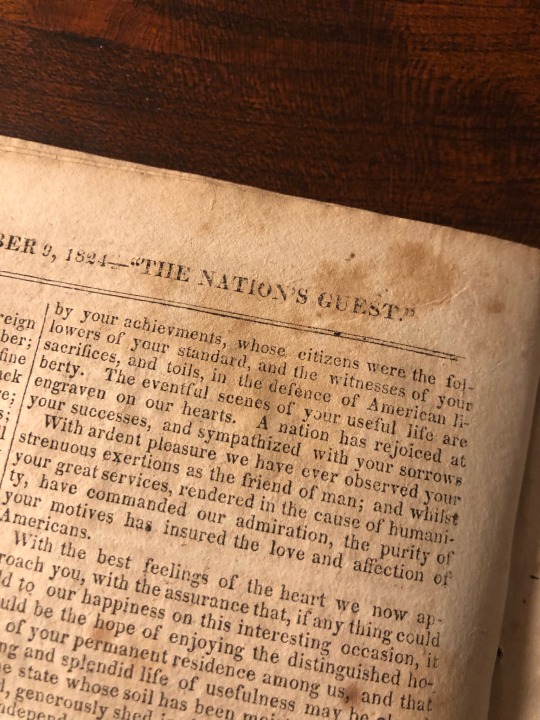

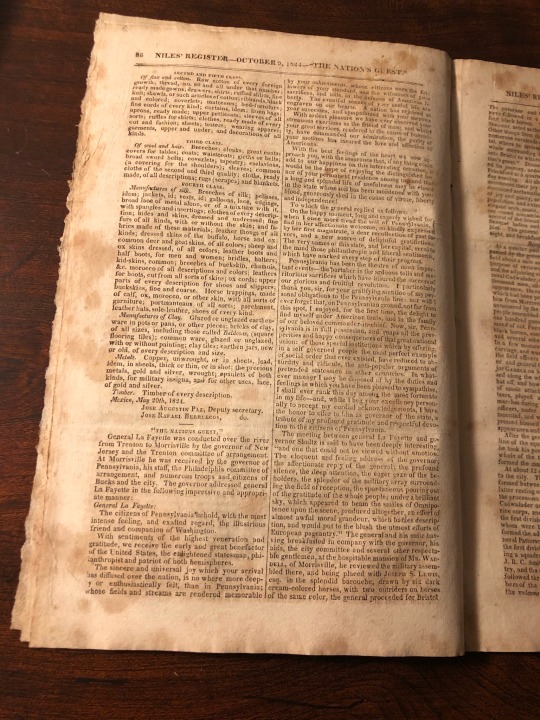


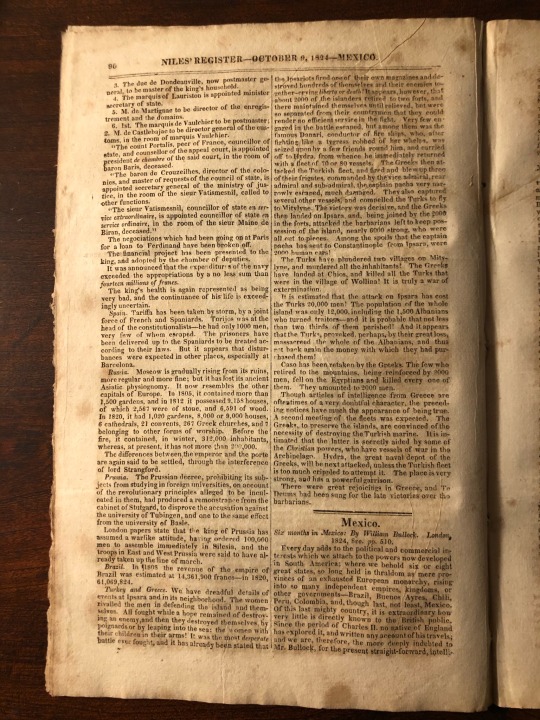
Niles’ Weekly Register - October 9, 1824, detailing Lafayette’s stop in Baltimore during his tour of the US as an older man. I recently found this gem and thought I’d share!
#marquis de lafayette#lafayette#gilbert du motier#1824-1825 Tour#Baltimore#Maryland#Niles’ Weekly Register#October 8 1824
30 notes
·
View notes
Text
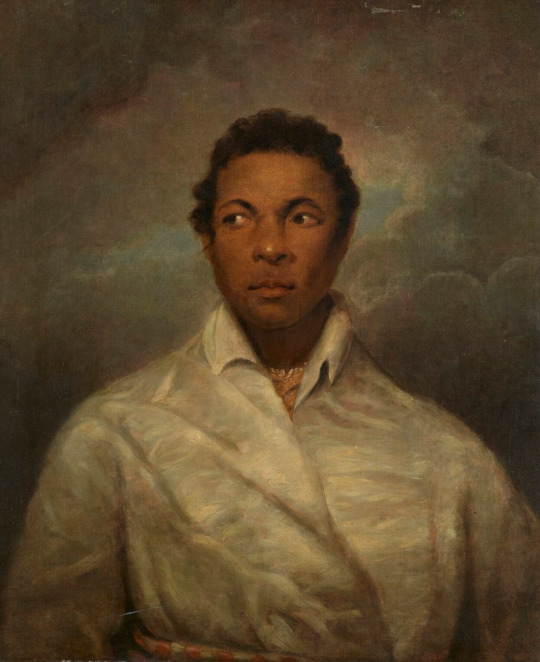
After James Northcote (1746-1831)
“Ira Aldridge” (c. 1826)
Oil on canvas
Located in the National Portrait Gallery, London, England
Ira Aldridge (1807-1867), born and raised in New York, came to Britain in 1824 and first appeared in the lead role of Othello at the Royalty Theatre in London the following year. In 1833 he made his West End debut playing Othello again at Covent Garden. Audiences were positive but reviews were mixed on the idea of a black actor in such a prestigious role. Aldridge continued to perform around Britain, seeking out various black roles as well as famous typically white roles, including Lear, Shylock, Macbeth, Richard III; he would tour Europe, becoming one of the highest paid actors in the world. His subsequent reputation led to a triumphant return to the London stage in 1855. Aldridge is the only actor of African-American descent among the 33 actors of the English stage honored with bronze plaques at the Shakespeare Memorial Theatre at Stratford-upon-Avon.
In 1825, James Northcote painted Ira Aldridge an American actor who was the first black actor to play Othello in Britain. This image is a copy of James Northcote's portrait of Aldridge which was bought by Manchester Art Gallery shortly after Aldridge's performance as Othello in Manchester. It is thought to represent Aldridge as Othello.
#paintings#art#artwork#genre painting#male portrait#james northcote#oil on canvas#fine art#history#african american#black man#handsome#othello#william shakespeare#side eye#actor#acting#theatre#theater#1820s#early 1800s#early 19th century
376 notes
·
View notes
Text
scandalous star: ira aldridge - an analysis
“A child of the sun, black my countenance, yet I stand before you in the light of my soul.” - Ira Aldridge
He was the most visible black man in a white world in the middle of the nineteenth century. This remarkable man, Ira Aldridge, was a black freedman New Yorker who moved to England when he was in his teens, and achieved immense fame in mid-nineteenth-century Europe as a Shakespearean actor, mesmerizing kings, emperors, and, it would seem, Richard Wagner with his renditions of Shakespeare. He was especially popular in Prussia (now modern-day northern Germany) and Russia, where he received top honours from heads of state. Aldridge's acting career took off at the height of the abolition movement. He chose to play a number of anti-slavery roles and often addressed his audiences on closing night, speaking passionately about the injustice of slavery. During his lifetime, Aldridge successfully challenged preconceived notions about the capabilities of Black people, but unfortunately his legacy faded from public consciousness after his death; he is now much more obscure, revealing the paradoxes of a man who falsified his biography, toyed with audiences, and undermined the racial assumptions of his age. Considered the first Black tragedian, Aldridge is an icon of the African-American theater and a source of inspiration for African-American actors, especially those of the stage.

Ira Aldridge, according to astrotheme, was a Leo sun and Pisces moon (the moon is speculative). Aldridge was born in New York to free African Americans, his father was a reverend at a local Black church and encouraged his son to follow in his footsteps. Aldridge studied at the New York African Free School, where he cultivated an interest in theater. Founded by the Manumission Society and abolitionists such as Alexander Hamilton, the institution intended to educate the children of enslaved individuals and free people of colour. As a teenager, Aldridge became affiliated with a Black theater community in lower Manhattan, and by the age of 15, he joined the short-lived African Company in 1821. Due to extreme racial discrimination in the United States, and finding no adequate outlet for his ambition in New York, Aldridge decided to set sail for Britain in 1824. While both Aldridge and his reviewers downplayed his American identity, Aldridge emphasized his African heritage, allowing it to become part of his theatrical trademark. In 1825, at the age of 17, he debuted as Othello in a small London theater and continued to star in abolitionist melodramas. He became known as a brilliant tragedian and comedian on stage and was dubbed the 'African Roscius' (referring to the great Roman actor) by enthusiastic theater reviewers. The British public's reception towards Aldridge was mixed. While his fame and popularity swelled, he was also shunned and ridiculed for his accent, mannerisms and skin colour. In African-American circles, Aldridge quickly became a legendary figure.
Before earning the part of Othello, Aldridge had been cast as a mythical African prince in an adaptation of Thomas Southerne's Oroonoko; his impressive skill, charisma and oratory capabilities inevitably swayed public opinion. He became known for directly addressing the audience about the injustices of slavery on the closing night of his play at a given theater. After Aldridge's debut at London's most prestigious theater, some reviewers protested about a Black actor appearing on stage. It is likely that the rare sighting of a person of colour on stage – and not as an enslaved person or servant – fascinated British audiences, especially as Aldridge's eloquence and talent would have undermined racist assumptions underpinning nineteenth-century attitudes. Aldridge spent much of the 1850s on the Continent, touring the Austro-Hungarian empire, Germany, Prussia, Switzerland, Poland and eventually travelling to Russia in 1858 where he was well received. Upon returning to England in the 1860s, he applied for British citizenship. His personal life was just as eventful as his professional one –in 1856 Aldridge was successfully sued by actor William Stothard, who alleged Aldridge had had an affair with his wife Emma three years before, resulting in the birth of a son. Although his white English wife, Margaret Gill, bore no children (their marriage angered the pro-slavery lobby, which attempted to end Aldridge's career), it is believed that he fathered at least six children by three other women, one of whom became his second wife, a Swede named Amanda von Brandt. Two of his daughters, Luranah and Amanda, became professional operatic singers. By the time of his death in 1867 visiting Łódź, Poland, Aldridge was an acclaimed and award-winning stage actor and the most visible Black figure in Europe. He had appeared on stage in more than 250 theatres across Britain and Ireland, and more than 225 theaters in Europe.
Next, I focus on a light-skinned black actress who was “too light to be black” yet not accepted in the white world; she instead fought on the front lines for civil rights for blacks. The criminally forgotten Capricorn Fredi Washington.

STATS
birthdate: July 24, 1807*
*note*: due to the absence of a birth time, this analysis will be even more speculative
major planets:
Sun: Leo
Moon: Pisces
Rising: unknown
Mercury: Leo
Venus: Virgo
Mars: Libra
Midheaven: unknown
Jupiter: Aquarius
Saturn: Scorpio
Uranus: Libra
Neptune: Scorpio
Pluto: Pisces
Overall personality snapshot: He had star quality but privately preferred to be a wallflower. He had a strong need for excellence and social approval, yet he honoured his own private, individual values more – and perhaps even came to expect there to be a conflict between his moral integrity and the demands of his audience. Very impressionable and easily moved by suffering, he was a mixture of self-assured certainty and oversensitive, confused uncertainty. Sometimes self-denying and withdrawn, other times autocratic and wilful, he had a great longing to belong as well as a strong need to be actively useful. When he combined these two sides, he was one of the most poetic and creative of all combinations with a spontaneous and childlike delight in the world, an immense sense of fun and a capacity to translate experience into words and colourful images. He could sometimes feel torn between his desire for plenty of peace and privacy, and his need for worldly success and the affection and approval of people he loved and respected. He had an essentially artistic temperament and needed to learn how to be his own best friend – how to look after his own best interests – as he was so easily drawn towards looking after others.
Whether or not he was overtly religious, there was a strongly reflective and devotional side to his nature. He may have even felt that it was nothing less than every human being’s duty to realize his or her immense spiritual potential. At the same time, he never lost his compassion for people and their problems and failures. He knew himself how he went through phases of striving and then retreat, successful self-expression and then, perhaps, a refusal to play the game if the cost to his integrity was too high. He could be severely shaken by the ways of the world, and yet it would be unhealthy for him to relinquish her active role altogether. Full of ardour and deep feeling for life, he was the lion-hearted mystic, the gentle king, the gullible sweetheart who would not harm a fly, the flamboyant, fiercely loyal friend who shared others’ sorrows and successes with equal intensity. He was courageous in the face of difficulties, ever true to his word through thick and thin, and dignified and hopeful even when pain absorbed him utterly as it was wont to do quite often. Changes of mood were his way of life, and if he could make them fodder for his creative imagination, they would have served her well. As a writer, a poet, an actor or any kind of artist, he indulged in his feelings dramatically, and readily transposed his inner life out into the world.
He was ambitious, sound at giving orders, carried responsibility well and was a good teacher, especially able to bring out the best in children. He believed in himself and generally knew the right thing to say at the right time, although he could show a stubborn and dogmatic side. He had a high opinion of his mental powers, and it was certainly true to say that he had plenty of mental energy. His sometimes erratic behaviour depended on his mood. He tended to have very strong intuitions about things and generally felt optimistic about the future. This gave him faith in his ability to succeed, and he could be very impatient with those who gave up without at least trying. He showed strong imagination and originality, and felt that by using his intellect to create, analyze and develop new ideas, he was allowing herself to grow. His mental abilities were likely to be the strongest and best expressed in the sciences, music and philanthropy. He was socially adept and enjoyed an extensive social life, although it may have operated on a fairly superficial level. He had strong reserves and a powerful sense of purpose. He was very serious when he set about achieving something, not wasting his time with useless efforts. He had enormous expectations of himself and of other people, and could be an extremely hard taskmaster. Sometimes he lacked flexibility and had a tendency to brood. He had a strong will, deep strength and force to his personality. Although he had great depth of feeling, he had enormous difficulty in expressing it.
He belonged to a generation that brought unconventional attitudes to marriage and close emotional relationships, believing in the equality and freedom of both partners. Personal relationships tended to be made and unmade fairly quickly. Civil rights were also an extremely important issue. As a member of this generation, he had some unusual artistic talents. He belonged to generation that showed a great interest in occult and metaphysical matters, but it was a generation that never seemed to be able to find complete satisfaction. As a part of this generation, he had a strong imaginative energy source, coupled with a very strong personal morality. As a child of this generation, Aldridge expressed an emotional intensity in his beliefs. Aldridge was part of a generation that was easily led astray by fantasy, and drugs and other addictive substances. Spirituality and religion were important to this generation, as well as compassion and the welfare of those around them, in particular their emotional welfare.
Love/sex life: He wanted sex to be real, tangible, and easily accessible. For this reason he was prone to divide his sexual contacts between those that served his physical needs and those that involved his search for the perfect relationship. His approach to the former was practical and matter-of-fact while he would look to the latter with dreamy fascination. This dual approach certainly did not make sense to everyone. Many people, including some potential partners, were apt to call him insensitive, along with a few other, less printable names. His attitude toward sex was essentially passive and downright lazy. Whether he was looking for love or just a good time he was easily led, emotionally lazy, and sometimes opportunistic. This lack of initiative made it difficult for him to find the perfect love that was always his utmost goal. Relationships of this sort require great energy and determination and there was a part of him that would always balk at such extraordinary effort. But if he was lucky enough to find a partner who was willing to do most or even all the work for him, he could be a lover well worth keeping.
minor asteroids and points:
North Node: Sagittarius
Lilith: Pisces
His North Node in Sagittarius dictated that he needed to prevent his idealism from influencing his thoughts to such a high degree. He needed to consciously develop a more clear-minded and analytical approach involving his thought processes. His Lilith in Pisces was a powerful muse in his life as an innovative male thinker; he was dangerously attracted to women who were natural born mystics and cultivated their own myth.
elemental dominance:
water
fire
He had high sensitivity and elevation through feelings. His heart and his emotions were his driving forces, and he couldn’t do anything on earth if he didn’t feel a strong effective charge. He needed to love in order to understand, and to feel in order to take action, which caused a certain vulnerability which he should (and often did) fight against. He was dynamic and passionate, with strong leadership ability. He generated enormous warmth and vibrancy. He was exciting to be around, because he was genuinely enthusiastic and usually friendly. However, he could either be harnessed into helpful energy or flame up and cause destruction. Confident and opinionated, he was fond of declarative statements such as “I will do this” or “It’s this way.” When out of control—usually because he was bored, or hadn’t been acknowledged—he was be bossy, demanding, and even tyrannical. But at his best, his confidence and vision inspired others to conquer new territory in the world, in society, and in themselves.
modality dominance:
fixed
He liked the challenge of managing existing routines with ever more efficiency, rather than starting new enterprises or finding new ways of doing things. He likely had trouble delegating duties and had a very hard time seeing other points of view; he tried to implement the human need to create stability and order in the wake of change.
house dominants:
10th
1st
2nd
His ambition in relation to the outside world, the identity he wished to achieve in regard to the community at large, and his career aspirations were all themes that were emphasized throughout his life. All matters outside the home, his public image and reputation were very important to him. His attitude to people in authority, and how he viewed the outside world, as well as the influence of his mother and his own attitude to her was highlighted. His personality, disposition and temperament is highlighted in his life. The manner in which he expressed himself and the way he approached other people is also highlighted. The way he approached new situations and circumstances contributed to show how he set about his life’s goals. The general state of his health is also shown, as well as his early childhood experiences defining the rest of his life. The material side of life including money and finances, income and expenditure, and worldly goods was emphasized in his life. Also the areas of innate resources, such as his self-worth, feelings and emotions were paramount in his life. What he considered his personal security and what he desired was also paramount.
planet dominants:
Sun
Saturn
Venus
He had vitality and creativity, as well as a strong ego and was authoritarian and powerful. He had strong leadership qualities, he definitely knew who he was, and he had tremendous will. He met challenges and believed in expanding his life. He believed in the fact that lessons in life were sometimes harsh, that structure and foundation was a great issue in his life, and he had to be taught through through experience what he needed in order to grow. He paid attention to limitations he had and had to learn the rules of the game in this physical reality. He tended to have a practical, prudent outlook. He also likely held rigid beliefs. He was romantic, attractive and valued beauty, had an artistic instinct, and was sociable. He had an easy ability to create close personal relationships, for better or worse, and to form business partnerships.
sign dominants:
Leo
Scorpio
Capricorn
He loved being the center of attention and often surrounded himself with admirers. He had an innate dramatic sense, and life was definitely his stage. His flamboyance and personal magnetism extended to every facet of his life. He wanted to succeed and make an impact in every situation. He was, at his best, optimistic, honorable, loyal, and ambitious. He was an intense, passionate, and strong-willed person. He was not above imposing his will on others. This could manifest in him as cruelty, sadism, and enmity, which had the possibility to make him supremely disliked. He needed to explore his world through his emotions. He was a serious-minded person who often seemed aloof and tightly in control of his emotions and his personal domain. Even as a youngster, there was a mature air about him, as if he was born with a profound core that few outsiders ever see. He was easily impressed by outward signs of success, but was interested less in money than in the power that money represents. He was a true worker—industrious, efficient, and disciplined. His innate common sense gave his the ability to plan ahead and to work out practical ways of approaching goals. More often than not, he succeeded at whatever he set out to do. He possessed a quiet dignity that was unmistakable.
Read more about him under the cut:
Ira Frederick Aldridge was the first African American actor to achieve success on the international stage. He also pushed social boundaries by playing opposite white actresses in England and becoming known as the preeminent Shakespearean actor and tragedian of the 19th Century.
Ira Frederick Aldridge was born in New York City, New York on July 24, 1807 to free blacks Reverend Daniel and Lurona Aldridge. Although his parents encouraged him to become a pastor, he studied classical education at the African Free School in New York where he was first exposed to the performance arts. While there he became impressed with acting and by age 15 was associating with professional black actors in the city. They encouraged Aldridge to join the prestigious African Grove Theatre, an all-black theatre troupe founded by William Henry Brown and James Hewlett in 1821. He apprenticed under Hewlett, the first African American Shakespearean actor. Though Aldridge was gainfully employed as an actor in the 1820s, he felt that the United States was not a hospitable place for theatrical performers. Many whites resented the claim to cultural equality that they saw in black performances of Shakespeare and other white-authored texts. Realizing this, Aldridge emigrated to Europe in 1824 as the valet for British-American actor James William Wallack.
Aldridge eventually moved to Glasgow, Scotland and began studies at the University of Glasgow, where he enhanced his voice and dramatic skills in theatre. He moved to England and made his debut in London in 1825 as Othello at the Theatre Royal Covent Garden, a role he would remain associated with until his death. The critic reviews gave Aldridge the name Roscius (the celebrated Roman actor of tragedy and comedy). Aldridge embraced it and began using the stage name “The African Roscius.” He even created the myth that he was the descendant of a Senegalese Prince whose family was forced to escape to the United States to save their lives. This deception erased Aldridge’s American upbringing and cast him as an exotic and almost magical being.
Throughout the mid-1820s to 1860 Ira Aldridge slowly forged a remarkable career. He performed in London, Liverpool, Edinburgh, Bath, and Bristol in King Lear, Othello, Macbeth, and The Merchant of Venice. He also freely adapted classical plays, changing characters, eliminating scenes and installing new ones, even from other plays. In 1852 he embarked on a series of continental tours that intermittently would last until the end of his life. He performed his full repertoire in Prussia, Germany, Austria, Switzerland, Hungary, and Poland. Some of the honors he received include the Prussian Gold Medal for Arts and Sciences from King Frederick, the Golden Cross of Leopold from the Czar of Russia, and the Maltese Cross from Berne, Switzerland.
Aldridge died on August 7, 1867 while on tour in Lodz, Poland. He was 60 at the time of his death. Aldridge had been married twice and left behind several children including a daughter named Luranah who would, in her own right, go on to become a well-known actress and opera singer. There is a memorial plaque at the Royal Shakespeare Theatre in Stafford-upon-Avon, in honor of his contributions to the performing arts. In 2014 a second plaque was unveiled in Lodz, Poland to honor his memory and legacy. (x)
7 notes
·
View notes
Photo
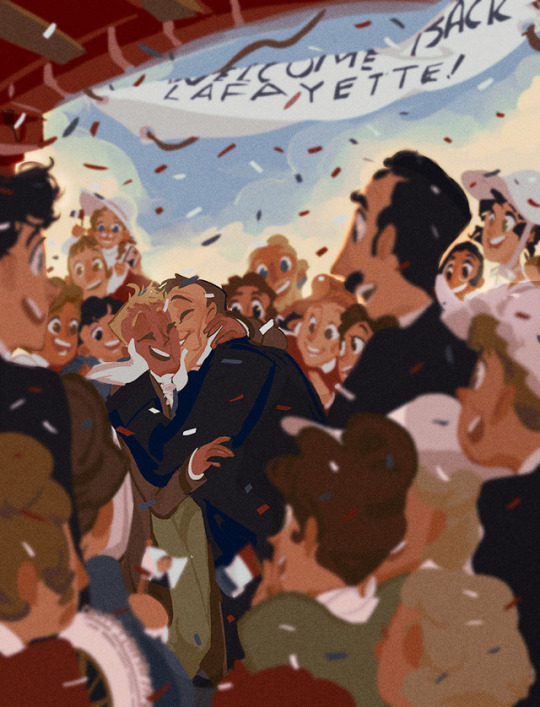
In 1824-1825 Lafayette the last remaining general of Revoutaltion returned to America to do a huge 24 state tour where he was welcomed like a rockstar. He had memorabilia made with his face, had giant crowds, party like every night. He was like the Beatles but way bigger.
Anyways I like the idea as Lafayette was received in his a huge welcoming Philaphia parade. He spots Aph America out in the monstrous crowd (wayyyy in the back). And even though he hasn't seen the nation since he was a young teen and looks quite different he just knows in his bones it’s him. So Lafayette demands his carriage to halt and jumps out sprints to greet the personification personally like he’s always done with many kisses to the cheeks. And America super surprise and overjoyed that his old friend remembers him.
America: You remember me!?
Lafayette: Oh how could anyone forget, you old friend, you are in my blood.
3K notes
·
View notes
Text
Liberian girl.
1816 December The American Colonization Society is founded at Davis Hotel in Washington to establish a colony for free black's as a solution to the race problem in the U. S.
1817 Cuffe passes away.

1820 February Reverend Samuel Bacon, John B. Bankson, Samuel S. Crozer, Daniel Coker and Captain Sebor sail on the ship Elizabeth from New York to Sherbok Island with 88 emigrants.
Bacon, Bankson, Crozer and 22 of the emigrants all die within 3 weeks from yellow fever.
Only 1, 819 of 4, 571 emigrants brought to Liberia between 1820 and 1843 survive.
1821 Lt. Robert Stockton threatens King Zolu Duma otherwise known King Peter with a gun to his head and the King sells Cape Mersurado.
1822 April 25 The emigrants brought to Sherbok Island by Cuffe are taken by another ship to Cape Mersurado where they establish the city of Christopolis.
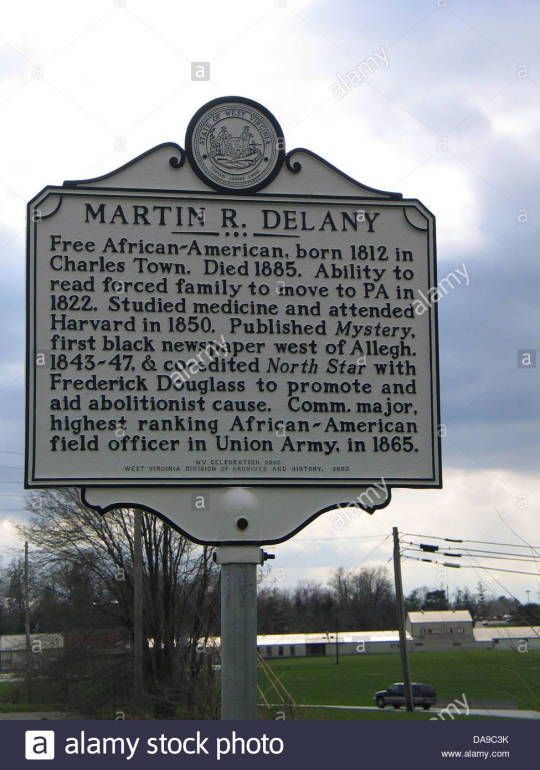
1824 The city of Christopolis is renamed Monrovia after President James Monroe who attended the meeting of the founding of the ANC.
1825 King Zolu Duma and other Kings sign a treaty with Ashmun granting land and are given 3 barrels of rum, 5 casks of powder, 5 umbrellas, 10 pairs of shoes, 19 iron posts, 500 bars of tobacco and some other items.
1826 Russwurm becomes the first African American to graduate from Bowdoing College marking him the third African American to graduate from an American college.
1827 Russwurm moves to New York.
March Russworm and Samuel Cornish co-found of the first African American owned newspaper, “Freedoms Journal”.
The Maryland Colonization Society named after the U. S. State of Maryland is founded.
1828 Charles Carroll of Carrollton becomes the Maryland Colonization Society's first president.

1829 March Jamaican John Brown Russworm resigns as senior editor of his newspaper Freedom's Journal and emigrates from the U. S. to Liberia.

1830 Russwurm the colonial secretary for the American Colonization Society serving from until 1834, becomes editor of the Liberia Herald and serves as the superintendent of education in Monrovia.
1831 Delany at age 19 moves to West Pittsburgh where he works as a barber and labourer.
1932 Cholera pandemic first outbreak in Pittsburgh.
Delany becomes apprentice to Dr. Andrew N. Mc Dowell, learns fire cupping and leeching techniques and also studies with abolitionist doctors such as Dr. F. Julius LeMoyne and Dr. Joseph P. Gazzam of Pittsburgh.
1836 Russwurm becomes the first black governor of the Maryland in Africa colony.
1842 Blyden moves to Venezuela.
1843 Delany begins publishing "The Mystery" the first black newspaper west of Allegh, his articles and writings are reprinted by William Lloyd Garrison in his “The Liberator”.
Delany also meets and marries Catherine A. Richards Pittsburgh.
1945 Blyden meets Reverend John P Knox Pastor of Saint Thomas Protestant Dutch Church.
1846 Delany is sued $650 for libel by an African American man by the name of Fiddler Johnson for accusing him in The Mystery of being a slave catcher.
1847 Delany meets Douglass and Garrison whilst they are in Pittsburgh on an anti-slavery tour and begins working with them to compile Douglass’s first abolitionist newspaper “the North Star”, printed from the basement of the Memorial African Methodist Episcopal Zion Church in Rochester, New York.
Delanys eulogy for Rev. Fayette Davis is widely redistributed.
1848 July Delany reports in the North Star that the jury in the Crosswait trial were instructed by U.S. District Court Justice John McLean to make it a punishable offence for a citizen to thwart those trying to “repossess” an alleged runaway slave, influencing abolitionist Salmon P. Chase's to remove McLean as a candidate of the Free Soil Party for the Presidency.

Robert
1850 Delany becomes one of the first three black men to successfully enroll at Harvard Medical School but is dismissed after just few weeks as the result of a race complaint by white students.
Edward Wilmot Blyden at age 18 travels from Venezuela to the U.S. with Mrs. Knox, the wife of his friend Reverend John P. Knox of the St. Thomas Protestant Dutch Reformed Church to enroll at Rutgers Theological College but is turned away by Rutgers as well as at 2 other theological colleges in the U.S. and as a result emigrates to Liberia.

Blyden edits the Liberia Herald and writes the column “A Voice From Bleeding Africa”.
The state of Virginia begin to put aside $30, 000 every year until 1855 to support emigration.
1852 Delany publishes his "The Condition, Elevation, Emigration and Destiny of the Colored People of the United States, Politically Considered."
1854 August Delany leads the National Emigration Convention in Cleveland, Ohio
Delany publishes his “Political Destiny of the Colored Race on the American Continent” and his "The Origins and Objects of Ancient Freemasonry: Its Introduction into the United States and Legitimacy among Colored Men."
Delany stays behind second Cholera outbreak in Pittsburgh to treat patients whilst many leave the city.
1856 Delany moves his family to Chatham, Ontario, Canada.
Blyden edits the Liberia Herald and writes the column "A Voice From Bleeding Africa".
1859 May Martin Delany, whos own paternal descent is that of the Golan people in western/northwestern Liberia and Eastern Sierra Leone, sails from New York to Liberia and in the Abeokuta region of what is now the state capital of the Ogun State in southwest Nigeria signs a treaty with chiefs of the Egba people agreeing for emigrants from the U. S. who are of African descent to establish a settlement there.
January-July Delany "Blake: Or The Huts of America" 1/2 is serialised in The Anglo-African Magazine, in which he criticizes Harriet Beecher Stowe for her portrayal of the slaves as too passive in her “Uncle Tom’s Cabin” but does however also approve her accurate account of the cruelty of slave owners in the south.
1860 Delany travels from Liberia to England where he is honoured by the International Statistical Congress.
1861 Blyden becomes professor of Greek and Latin at Liberia College as well as the Secretary of State of Liberia.
Delany Blake: Or the Huts of America 2/2 is published in Weekly Anglo African Magazine.
April 12 Friday 4:30 a.m. The Civil War begins with the Battle of Fort Sumter in Charleston Harbor, Confederate opens fire, firing for 34 straight hours, on the fort Sumter.
7:00 a.m. Captain Abner Doubleday, the forts second in command fires the first shot.
Lt. Norman J. Hall's eye brows are burnt off as he attempts to put the fallen Union colors back up.
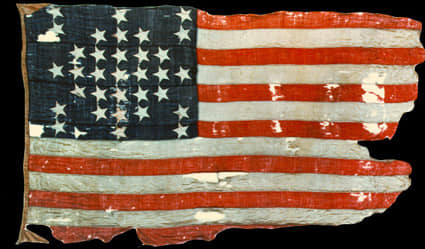
April Major Robert Anderson surrenders the fort and lowers the flag.
1862 Blyden becomes Liberian Secretary of State.
May 13 Robert Smalls sails the USS Planter from the Confederate controlled waters of Charleston harbor past 5 Confederate harbor forts to the Union blockade ships.
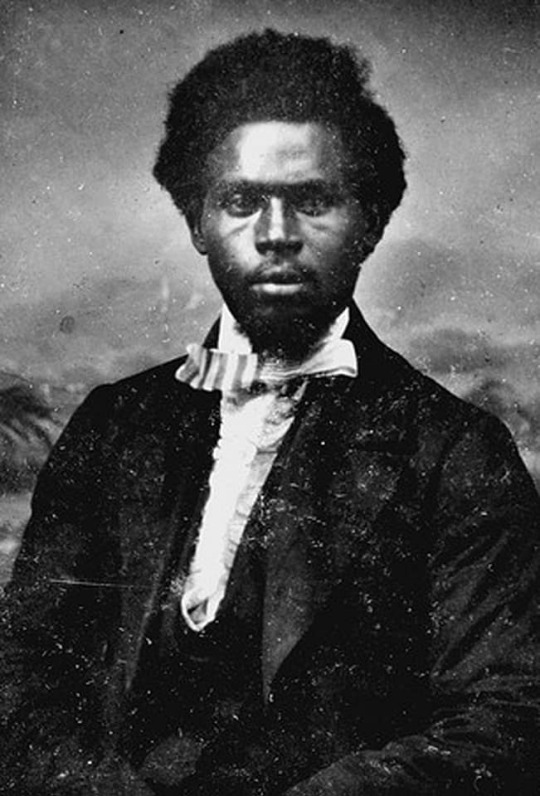
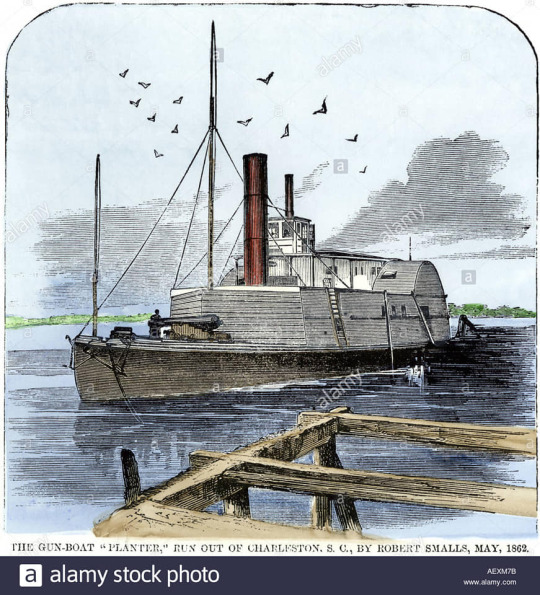
1863 Delany begins recruiting black men for the Union Army United States Colored Troops, his efforts in Rhode Island, Connecticut and Ohio raise thousands of enlistees many of whom join the new United States Coloured Troops.
Delany also writes to secretary of war Edwin Stanton asking him "to command all of the effective black men as Agents of the United States".
179, 000 black men enlist in the U.S. Coloured Troops almost 10% of those who serve in the Union army.
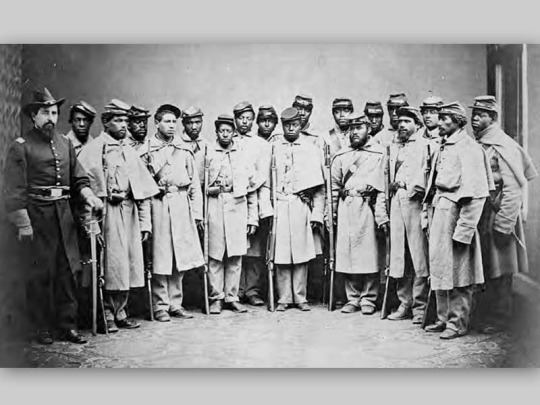

1865 February Anderson is commissioned with the rank of Major General and Delany becomes the first black line field officer in the U.S. Army as well as the only black officer to receive commission of the highest rank, that being of the rank of Major.

Delany also meets Abraham Lincoln to which he puts forth the idea of a Corps of black men led by black officers to appeal to blacks in the south.
April 14 Smalls arrives with Delany and Robert Vesey son of hanged black abolitionist, Denmark Vesey in the Planter ship at the War Department ceremony in Charleston, South Carolina.
Anderson unfurls the Union flag above Fort Sumter, Garrison and Senator Warner are included as speakers and Massachusetts Senator Henry Wilson and abolitionist Henry Ward Beecher are also among those who attend the ceremony.
April 15 President Lincoln is assassinated by John Wilkes Booth.
Delany publishes an open letter asking African Americans for contributions towards a Lincoln memorial.
Delany serves under General Rufus Saxton in the 52nd U.S. Colored Troops and is later transferred to the Freedman Bureau in Hilton Head.
1974 Delany runs as an Independent Republican for Lieutenant Governor of South Carolina (with John T. Green as the gubernatorial candidate), Former Republican Franklin Moses Jr. looses ticket to Republican Attorney Daniel H. Chamberlain.
1875 Delany is charged with defrauding a church and forced to resign from his position Trail Justice, he is sentenced to jail but is pardoned by the Republican Governor with the intervention of Wade Hampton.
1876 Delany supports Hampton as Democratic candidate in the gubernatorial election.
1877 Delany becomes chairman of the Charleston Liberian Exodus Joint Steamship Company finance committee and the company purchase the 400 ton Azor.
1878 Delany and Liberian Exodus Joint Steamship Company make the voyage from Charleston to Monrovia with Harrison N. Bouey.

1880 Blyden serves as President of Liberia College for 4 years.
1885 January 24 Delany dies of tuberculosis in Wilberforce, Ohio.
Blyden presidential election for the Republican Party loses to Hilary R. W. Johnson.
1896 Turner receives James Mata Dwane of South Africa, former Methodist Minister and a member of the Ethiopian Church of Mangena Mokone accompanied by H. B. Parks and J. S. Flipper.

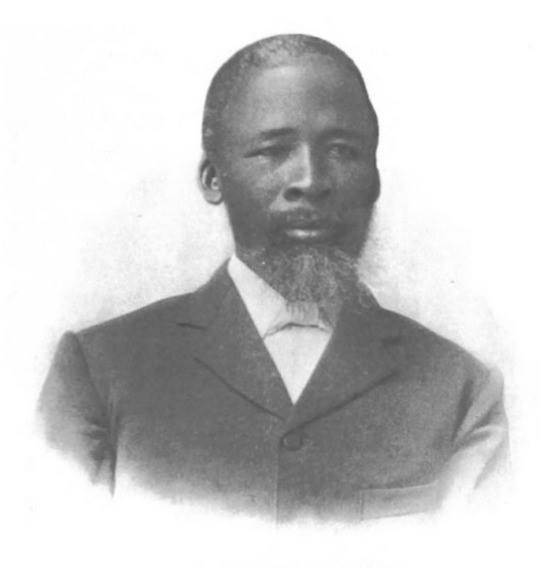
Turners second ship of emigrants sail for Liberia.
1898 February Turner in his "Voice of Missions" newspaper says "We have as much right biblically and otherwise to believe that God is a Negroe, as you or white people have to believe that God is a fine looking, symmetrical and ornamented white man. For the bulk of you and all the fool Negroes of the country believe that God is white-skinned, blue eyed, straight-haired, projected nosed, compressed lipped and finely robed white gentleman, sitting upon a throne somewhere in the heavens. Every race of people who have attempted to describe their God by words, or by paintings, or by carvings, or any other form or figure, have conveyed the idea that the God who made them and shaped their destinies was symbolized in themselves, and why should not the Negroe believe that he resembles God."
1921 February 1 UNIA six-man delegation leaves for Liberia.
March 7 President C. D. B. King of Liberia arrives in New York as head of the United States Liberian Plenary Commissione to negotiate loan and 5 man UNIA welcoming delegation pays greeting call at Waldorf Astoria Hotel.
March 18 The UNIA mission arrives in Monrovia.
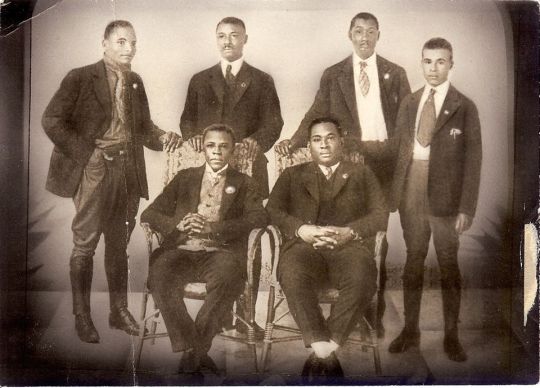
March 22 The UNIA delegates to Liberia hold an official interview with Liberia’s acting president.
April The UNIA delegates stop “construction work” temporarily because of lack of funds.
Rev. F. Wilcom Ellegor, UNIA high commissioner meets with President C.D.B. King in Washington D.C., regarding the UNIA Liberia construction loan.
June 27 UNIA potentate, Gabriel M. Johnson, leaves Liberia for New York to attend Second UNIA convention.
Potentate.

June 29 State Department seeks to stop voyage of Johnson.
June Crisis publish open letter signed by president C. D. B. King renouncing ties with UNIA.
July 14-16 Johnson arrives in New York; interviewed by BOI agents detained for examination by United States Immigration on Ellis Island; finally admitted.
August 1 Opening of second UNIA convention; keynote speech delivered by UNIA potentate, Gabriel M. Johnson.
August 4 Garvey delivers official convention report; writes official letter to President C.D.B. King.
1923 December 11 UNIA delegation departs for Liberia via Lisbon, Portugal on the Cunard vessel S. S. Britannia.

The delegation is led by Henrietta Vinton Davis and also included Princeton education Robert Piston and UNIA new attorney Milton Van Lowe.
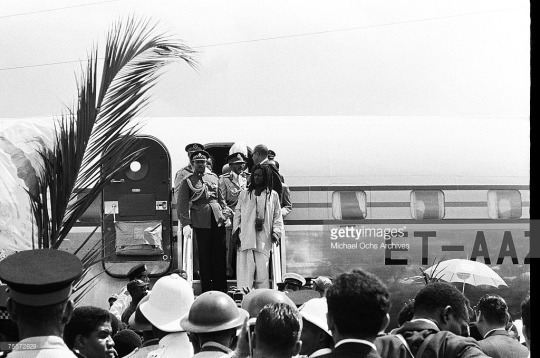

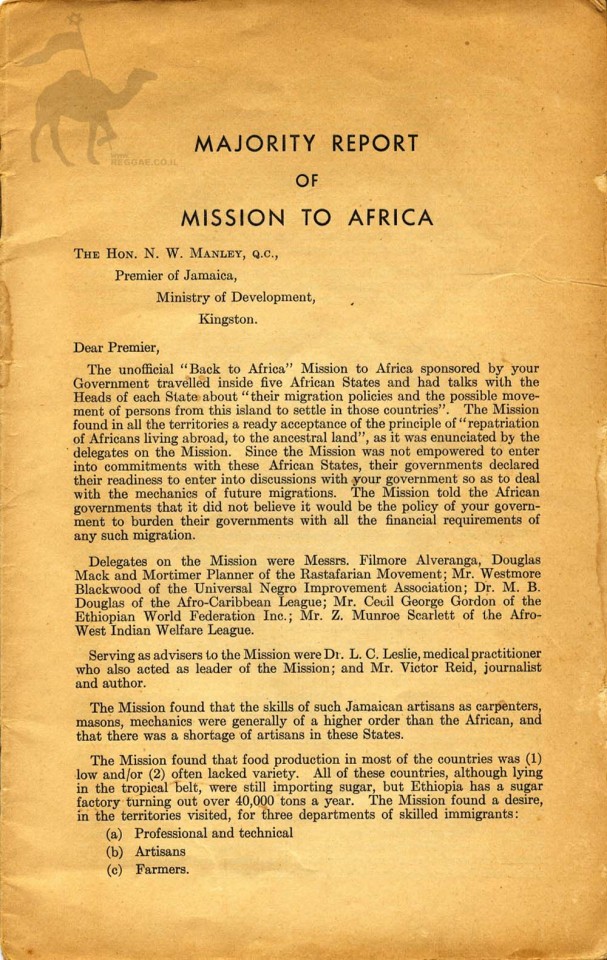
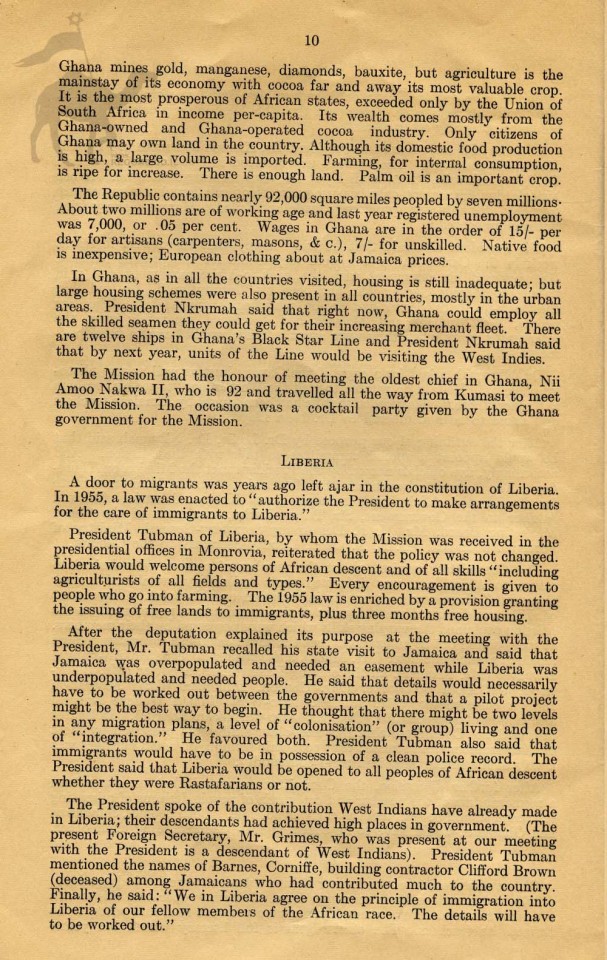


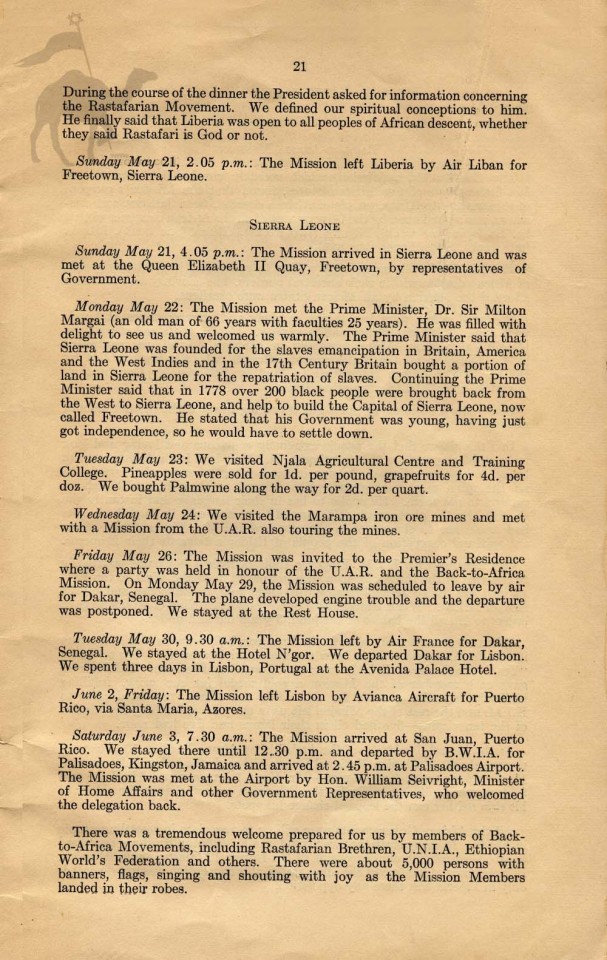
5 notes
·
View notes
Text
1815 Cuffe arrives at Sherbrooke Island in present day Sierra Leone with 88 African Americans, the first. 1816 December The American Colonization Society is established. 1820 The ship Elizabeth sails from New York to Sierra Leone and Liberia with 88 emigrants. and 22 emigrants die within 3 weeks from yellow fever and of the 4, 571 emigrants brought to Liberia between this year and 1843 only 1, 819 survive. 1821 Lt. Robert Stockton points a pistol to King Peter’s head and King Peter sells Cape Mersurado. 1822 January 7 The emigrants brought to Sherbrooke Island by Cuffe are taken to Cape Mersurado by another ship and there they establish the city of Christopolis. 1824 The city of Christopolis is renamed Monrovia after President James Monroe. 1825 King Peter and other Kings sign a treaty with Ashmun granting land and are given 3 barrels of rum, 5 caskets 1829 March Jamaican John Brown Russworm co founder of the first African American owned newspaper, “Freedoms Journal” emigrates from the U. S. to Liberia. 1830 Russwurm found employment as the colonial secretary for the American Colonization Society serving from until 1834 and also worked as the editor of the Liberia Herald and served as the superintendent of education in Liberia’s capital, Monrovia. 1836 Russwurm becomes the first black governor of the Maryland in Africa colony which was annexed Liberia in 1857. 1845 The ACS draft a constitution at a convention held in Monrovia. 1847 Liberia delcares its independence becoming an independent and sovereign Republic using the constitution. 1848 January 3 Joseph Jenkins Roberts is elected Liberia’s first president. 1850 Edward Wilmot Blyden at age 18 emigrates to Liberia after unsuccessfully enrolling in Rutgers Theological College as well as 2 other theological colleges in the U.S. Blyden had made the trip to the U.S. with the wife of John P. Knox, pastor of St. Thomas Protestant Dutch Reformed Church. The state of Virginia begin to put aside $30, 000 every year until 1855 to support emigration. Blyden edits the Liberia Herald and writes the column “A Voice From Bleeding Africa”. 1859 May Martin Delany, whos own paternal descent was that of Goan sails from New York to Liberia where he and chiefs in the Abeokuta region make an agreement similarly to for to unused land. Earlier that same year Delany had published parts of Blake: Or The Huts of America in response to Harriet Beecher Stowe’s “Uncle Tom’s Cabin”, in which he criticized for inaccurately portraying the slaves as too passive although for cruelty of Southern slave owners, the first half of part one is serialised in The Anglo-African Magazine between January to July. 1860 Delany leaves Liberia for England and there he is honoured by the International Statistical Congress, and returns to America shortly. 1835 Delany attends the National Negro Convention in Philadelphia. 1843 Delany begins publishing The Mystery black newspaper, his articles and writings are reprinted in William Lloyd Garrisons “The Liberator” and also meets and marries Catherine A. Richards Pittsburgh. 1846 Delany is sued $650 for libel by an African American, Fiddler Johnson, who he accused in The Mystery newspaper of being a slave catcher. 1847 Delany meets Douglass and Garrison whilst they are in Pittsburgh on an anti-slavery tour and helps to put together Douglass’s first abolitionist newspaper “the North Star”, printed from the basement of the Memorial African Methodist Episcopal Zion Church in Rochester, New York. Delanys eulogy for Rev. Fayette Davis is widely redistributed. Delany recruits for the Union Army. His son Touissant Louverture Delany serves with the 54th regiment. 1848 July Delany reports in the North Star that the jury in the Crosswait trial were instructed by U.S. District Court Justice John McLean to make it a punishable offence for a citizen to thwart those trying to “repossess” an alleged runaway slave, and as a result influences abolitionist Salmon P. Chase to remove McLean as a candidate of the Free Soil Party for the Presidency. 1850 Delany becomes one of the first of three black men to attend Harvard Medical School but is dismissed in after a few weeks on account of a race complaint from white students. 1852 Delany publishes his The Condition, Elevation, Emigration and Destiny of the Colored People of the United States, Politically Considered. 1854 Delany publishes The Origins and Objects of Ancient Freemasonry: Its Introduction into the United States and Legitimacy among Colored Men. Delany, in the second Cholera outbreak stays behind in Pittsburgh to treat patients whilst many leave the city. August Dealany leads the National Emigration Convention in Cleveland, Ohio. and publishes his “Political Destiny of the Colored Race on the American Continent”. 1856 Delany moves his family to Chatham, Ontario, Canada. 1861 Delanys second part of part one series is published in Weekly Anglo African Magazine, he also prepares to embark Abeokuta but abandon plans abolition Delany begins recruiting black men for the Union Army Rhode Island, Connecticut and Ohio raising thousands of enlistees many joining the new United States Coloured Troops, his son serving in the 54th regiment, writes to secretary of war Edwin Stanton 179, 000 black men enlisting in the U.S. Coloured Troops making up almost 10% of those serving in the Union army. 1865 February Delany meets Abraham Lincoln and proposes the creation of a Corps of black men led by black officers to attract blacks in the south. Delany becomes the first black line field officer in the U.S. Army as well as the only black officer to receive commission of the highest rank of Major during the Civil War. April 14 Delany invited to the War Department ceremony in Charleston, South Carolina, attending with Robert Vesey son of hanged black abolitionist, Denmark Vesey in ship named the Planter former slave Robert Smalls, Major Genral Robert Anderson Fort Sumter 1861, abolitionist William Lloyd Garrison Senator Warner speak, Massachusetts Senator Henry Wilson and abolitionist Henry Ward Beecher. 1861 Blyden becomes professor of Greek and Latin at Liberia College and becomes Liberian Secretary of State. 1877 Delany became chairman of the Liberian Exodus Joint Steamship Company finance committee they bought the 400 ton ship Azor. 1878 The following year the company made the voyage from Charleston to Monrovia with captain Harrison N. Bouey. Blyden serves as President of Liberia College for 4 years. 1887 Blyden publishes his Christianity, Islam and the Negro Race. 1895 17 years later Bishop Henry Mc. Turner was responsible for two ships with 500 emigrants sailing to Liberia in 1895 and 1896. The year after he also received James Mata Dwane of South Africa along with H. B. Parks and J. S. Flipper. Dwane previously a South African Methodist Minister had left the Methodist Church to join the Ethiopian Church of Mangena Mokone in the same year and was also the founder of the Order of Ethiopia in the Anglican Church.
2 notes
·
View notes
Text
24 Days of La Fayette - Day 2
After beginning with one of my favourite portraits, let us continue with one of La Fayette’s favourite portraits of himself. This one:

Lafayette by Ary Scheffer, 1822-1823 via Wikipedia (12/02/2023)
It was a painted by the Dutch-French artist Ary Scheffer around 1822. The portrait was intended as a commemoration and present for La Fayette final visit to America - his Triumphant Tour in 1824/25. This was not the only work done by Scheffer for La Fayette, neither prior nor after the Tour.
The portrait accompanied him on this tour and La Fayette and Scheffer gifted it to the House of Representatives in 1824 when La Fayette was the first foreign visitor to address both the Senate and the House of Representatives in a joint meeting. To this day, it still hangs in the House Chamber (it was first displayed in the Capital Rotunda). The portrait was very well received by the people of the day. The newspapers wrote how close it resembled General La Fayette and no less than 27 state-banks featured the portrait on their currency. Many artists wanted to paint La Fayette during this momentous event but he neither had the time, nor the patience to sit for every single one of them. Instead, they copied this painting and made numerous engravings and prints. That is the reason why you see a number of copies and variations of this painting on the internet.
There is also an hilarious anecdote connected to this painting.
When Ary Scheffer was painting his portrait, someone asked the General how he was posed. He said:
“I am taking a walk - my hat and cane in my hand - like this.”
“And the other hand?”
“It is in my pocket, which is much better than having it in somebody else’s”
American friends of Lafayette, Gazette of the American Friends of Lafayette, No. 03, p. 3, May 1944. (12/02/2023)
#24 days of la fayette#marquis de lafayette#la fayette#french history#american history#history#art#ary scheffer#tour of 1824/1825#1822#1823
26 notes
·
View notes
Text
A Mixed Bag of Historical Accuracy
Author: Virginia Pollock
While this hand painted silk bag may seem like a simple fashion accessory, in reality it marks one of the most celebrated events in 1824 in the city of New York. On the backside of the purse there is an inscription that reads: “Landing of General Lafayette / at the Castle Garden New York / August 16, 1824.”
As the inscription states, the Marquis de Lafayette (1757-1834) landed at Castle Garden, now known as Castle Clinton, in what would mark the start of a whirlwind thirteen-month tour of twenty-four states. Lafayette had not returned to the United States after leaving in 1781 and this visit was set to celebrate his role in helping to win the Revolutionary War. By this time, the conflict was fading in the public memory and Lafayette was one of the last living figures who had fought in the war.[1] The commemoration of such a momentous tour created a frenzy for commemorative goods, including playing cards, gloves, waistcoats, and ceramics, most of which were adorned with his likeness.[2]
While these celebrations presented Lafayette as a mythic figure of a storied American past and blended fact and fiction, there are accounts of his landing at Castle Garden to compare with the painted silk image. One eyewitness described how the “aquatic procession then moved to the city, followed in the rear by the ship Cadmus, beautifully decorated, towed by two of the steamboats.”[3] August Levasseur, Private Secretary to Lafayette, recorded that “the sea was covered with boats of every sort, elegantly decorated with flags and filled with people,” painting a picture of the thousands of people gathered to greet Lafayette, and how they were accompanied by a military guard.[4]
Taking these observations into account, the painter of the silk bag translated these events into an accurate design. The composition is filled with boats, as well as part of the grand military welcome on the shore. While lacking the recorded number of crowds, the image proves to be a blend of fact and artistic fiction, making this item a fashionable and timely accessory.
Virginia Pollock is a Curatorial Fellow in the Textiles department at Cooper Hewitt, Smithsonian Design Museum, and a first-year graduate student in the History of Design and Curatorial Studies program offered jointly by Cooper Hewitt and Parsons School of Design.
[1] Anne C. Loveland, Emblem of Liberty: The Image of Lafayette in the American Mind (Baton Rouge, Louisiana State University Press, 1971), 3-5.
[2] Stephanie Kermes, Creating an American Identity: New England, 1789–1825 (New York: Palgrave Macmillan, 2008), 119.
[3] John Foster, A sketch of the tour of General Lafayette, on his late visit to the United States, 1824 (Portland: A.W. Thayer, 1824), 58.
[4] Auguste Levasseur, Lafayette in America in 1824 and 1825; or, Journal of a Voyage to the United States, trans. Dr. John D. Godman (Philadelphia: Carey and Lea, 1829), 14-15.
from Cooper Hewitt, Smithsonian Design Museum https://ift.tt/2S4pbRN
via IFTTT
2 notes
·
View notes
Text
Ira Aldridge


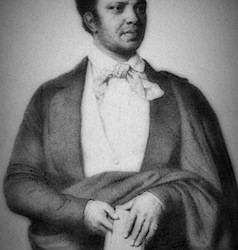


Ira Frederick Aldridge (July 24, 1807 – August 7, 1867) was an American and later British stage actor and playwright who made his career after 1824 largely on the London stage and in Europe, especially in Shakespearean roles. Born in New York City, Aldridge is the only actor of African-American descent among the 33 actors of the English stage honored with bronze plaques at the Shakespeare Memorial Theatre at Stratford-upon-Avon. He was especially popular in Prussia and Russia, where he received top honors from heads of state.
He was married twice, once to an Englishwoman, once to a Swedish woman, and had a family in England. Two of his daughters became professional opera singers.
Early life and career
Aldridge was born in New York City to Reverend Daniel and Luranah Aldridge on July 24, 1807. At age 13, Aldridge went to the African Free School in New York City, established by the New York Manumission Society for the children of free black people and slaves. They were given a classical education, with the study of English grammar, writing, mathematics, geography, and astronomy. His classmates at the African free school included Charles L. Reason, George T. Downing, and Henry Highland Garnet. His early exposure to theater included viewing plays from the high balcony of the Park Theatre, New York's leading theater of the time, and seeing productions of Shakespeare's plays at the African Grove Theatre.
Aldridge's first professional acting experience was in the early 1820s with the African Company, a group founded and managed by William Henry Brown and James Hewlett. In 1821, the group built the African Grove Theatre, the first resident African-American theatre in the United States.
Aldridge made his acting debut as Rolla, a Peruvian character in Richard Brinsley Sheridan's Pizarro. He may have also played the male lead in Romeo and Juliet, as reported later in an 1860 memoir by his schoolfellow, Dr. James McCune Smith.
Confronted with the persistent discrimination which black actors had to endure in the United States, Aldridge emigrated to Liverpool, England, in 1824 with actor James Wallack. During this time the Industrial Revolution had begun, bringing about radical economic change that helped expand the development of theatres. The British Parliament had already outlawed the slave trade and was moving toward abolishing slavery in the British colonies, which increased the prospect of black actors being able to perform.
Having limited onstage experience and lacking name recognition, Aldridge concocted a story of his African lineage, claiming to have descended from the Fulani princely line. By 1831 he had taken the name of Keene, a homonym for the then popular British actor, Edmund Kean. Aldridge observed a common theatrical practice of assuming an identical or similar nomenclature to that of a celebrity in order to garner attention. In addition to being called F.W. Keene Aldridge, he would later be called African Roscius, after the famous Roman actor of the first century BCE.
On October 10, 1825, Aldridge made his European debut at London's Royal Coburg Theatre, the first African-American actor to establish himself professionally in a foreign country. He played the lead role of Oroonoko in The Revolt of Surinam, or A Slave's Revenge; this play was an adaptation of Thomas Southerne's Oroonoko (itself adapted from Aphra Behn's original work).
According to the scholar Shane White, English people had heard of the African Theatre because of British actor and comedian Charles Mathews, so Aldridge associated himself with that. Bernth Lindfors says:
[W]hen Aldridge starts appearing on the stage at the Royalty Theatre, he's just called a gentleman of color. But when he moves over to the Royal Coburg, he's advertised in the first playbill as the American Tragedian from the African Theater New York City. The second playbill refers to him as 'The African Tragedian'. So everybody goes to the theater expecting to laugh because this is the man they think Mathews saw in New York City.
An innovation Aldridge introduced early in his career was a direct address to the audience on the closing night of his engagement at a given theatre. Especially in the years leading up to the emancipation of all slaves in the British colonies in 1832, he would speak of the injustice of slavery and the passionate desire for freedom of those held in bondage.
Critique
During Aldridge's seven-week engagement at the Royal Coburg, the young actor starred in five plays. He earned admiration from his audiences while most critics emphasized Aldridge's lack of stage training and experience. According to modern critics Errol Hill and James Vernon Hatch, early reviews were mixed. For The Times he was "baker-kneed and narrow-chested with lips so shaped that it is utterly impossible for him to pronounce English"; the Globe found his conception of Oroonoko to be very judicious and his enunciation distinct and sonorous; and The Drama described him as "tall and tolerably well proportioned with a weak voice that gabbles apace."
Aldridge performed scenes from Othello that impressed reviewers. One critic wrote, "In Othello (Aldridge) delivers the most difficult passages with a degree of correctness that surprises the beholder." He gradually progressed to larger roles; by 1825, he had top billing at London's Coburg Theatre as Oronoko in A Slave's Revenge, soon to be followed by the role of Gambia in The Slave, and the title role of Shakespeare's Othello. He also played major roles in plays such as The Castle Spectre and The Padlock. In search of new and suitable material, Aldridge also appeared occasionally as white European characters, for which he would be appropriately made up with greasepaint and wig. Examples of these are Captain Dirk Hatteraick and Bertram in Rev. R. C. Maturin's Bertram, the title role in Shakespeare's Richard III, and Shylock in The Merchant of Venice.
Touring and later years
In 1831 Aldridge successfully played in Dublin; at several locations in southern Ireland, where he created a sensation in the small towns; as well as in Bath and Edinburgh, Scotland. The actor Edmund Kean praised his Othello; some took him to task for taking liberties with the text, while others attacked his race. Since he was an American black actor from the African Theatre, The Times called him the "African Roscius", after the famed actor of ancient Rome. Aldridge used this to his benefit and expanded African references in his biography that appeared in playbills. In June 1844 he made appearances on stage in Exmouth (Devon, England).
Aldridge first toured to continental Europe in 1852, with successes in Germany, where he was presented to the Duchess of Saxe-Coburg-Gotha, and performed for Frederick William IV of Prussia; he also performed in Budapest. An 1858 tour took him to Serbia and to Imperial Russia, where he became acquainted with Count Fyodor Tolstoy, Mikhail Shchepkin and the Ukrainian poet and artist Taras Shevchenko, who did his portrait in pastel.
Now of an appropriate age, about this time, he played the title role of King Lear (in England) for the first time. He purchased some property in England, toured Russia again (1862), and applied for British citizenship (1863).
Marriage and family
Soon after going to England, in 1824 Aldridge married Margaret Gill, an English woman. They were married for 40 years until her death in 1864.
Aldridge's first son, Ira Daniel, was born in May 1847. The identity of his mother is unknown, but it could not have been Margaret Aldridge, who was 49 years old and had been in ill health for years. She raised Ira Daniel as her own; they shared a loving relationship until her death. He emigrated to Australia in February 1867.
A year after Margaret's death, on April 20, 1865, Aldridge married his mistress, the self-styled Swedish countess Amanda von Brandt (1834-1915). They had four children: Irene Luranah, Ira Frederick and Amanda Aldridge, who all went on to musical careers, the two girls as opera singers. Their daughter Rachael Frederica was born shortly after Aldridge's death and died in infancy. Brandt died in 1915 and is buried at Highgate Woods, London.
Aldridge spent most of his final years with his family in Russia and continental Europe, interspersed with occasional visits to England. He planned to return to the post-Civil-War United States, but he died in August 1867 while visiting Łódź, Poland.
His remains were buried in the city's Evangelical Cemetery; 23 years passed before a proper tombstone was erected. His grave is tended by the Society of Polish Artists of Film and Theatre.
A half-length portrait of 1826 by James Northcote shows Aldridge dressed for the role of Othello, but in a relatively undramatic portrait pose, is on display at the Manchester Art Gallery (in the Manchester section). Aldridge performed in the city many times. A blue plaque unveiled in 2007 commemorates Aldridge at 5 Hamlet Road in Upper Norwood, London. The plaque describes him as the 'African Roscius'.
Ira Aldridge Troupe
Aldridge enjoyed enormous fame as a tragic actor during his lifetime, but after his death, he was soon forgotten [in Europe]. The news of Ira Aldridge's death in Poland and the record of his achievement as an actor reached the American black community slowly. In African-American circles, Aldridge was a legendary figure. Many black actors viewed him as an inspirational model, so when his death was revealed, several amateur groups sought to honor his memory by adopting his name for their companies.
Many troupes were being founded in various places around America. In the late nineteenth century Aldridge-titled troupes were established in Washington, DC, in Philadelphia, and in New Haven, their respective productions at the time being an adaptation of Kotzebue's Die Spanier in Peru by Sheridan as Pizarro in 1883, School by Thomas William Robertson in 1885, and George Melville Baker's Comrades in 1889.
The most prominent troupe named for him was the Ira Aldridge Troupe in Philadelphia, founded in 1863, some 35 years after Aldridge left the US for good. The Ira Aldridge Troupe was a minstrelsy group that caricatured Irish white men. The Ira Aldridge Troupe is unique in annals of minstrelsy; it was named for a Black actor who had left his homeland some 35 years before and achieved fame in Europe. Unlike most, later, Black minstrel companies, the Aldridge Troupe apparently did not do plantation material, although they were billed as a 'contraband troupe'—that is, fugitive slaves. Perhaps because of their substantially Black audience, the troupe felt no need to "put on the mask." Although much of the material the group performed was standard fare, several of the company's acts were downright subversive.
The Ira Aldridge Troupe appearing during the American Civil War made it "unique in the annals of minstrelsy." The Clipper (New York City) thought it was important enough to review; and it performed before a mixed audience, at a time when often white and black audiences were separated. Third, it was a black troupe presenting a program designed to appeal to their black audience. The Ira Aldridge Troupe performances eschewed the southern genre of old "darkies" longing for the plantation. The exclusion of southern nostalgia may have been in deference to a majority-black audience. The New York Clipper reported them as "A more incorrigible set of cusses we never saw; they beat our Bowery gods all to pieces."
The troupe also created performances and songs that referred to the continuing Civil War. A ballad, "When the Cruel War is Over", became well known; it was performed by three members of the troupe—Miss S. Burton, Miss R. Clark, and Mr. C. Nixon. The song sold over a million copies of sheet music and was one of the most popular sentimental songs of the Civil War. The song describes a soldier's farewell to his lady, the wounds he receives in battle, and his dying request for a last caress. The song, highly popular with white minstrel groups, was an example of the change in white minstrelsy that had been occurring at this time.)
Another popular production was a farce called The Irishman and the Stranger, with a Mr. Brown playing a character called Pat O'Callahan and a Mr. Jones playing the Stranger. This farce displayed black actors in white face speaking in a "nigger accent". The Clipper reporter referred to the performance as a "truly laughable affair, the 'Irish nagur' mixing up a rich Irish brogue promiscuously with the sweet nigger accent". Perhaps the Aldridge Troupe's audience got its biggest satisfaction, however, from the role reversal inherent in the piece: since the beginning of minstrelsy, minstrels of Irish heritage, such as Dan Bryant and Richard Hooley, had been caricaturing Black men—now it was the turn of Black men to caricature the Irish.
The history of minstrelsy also shows the cross-cultural influences, with Whites adopting elements of Black culture. The Ira Aldridge Troupe tried to pirate that piracy, and, in collaboration with its audience, turn minstrelsy to its own ends.
Aldridge family
Ira Daniel Aldridge, 1847–?. Teacher. Migrated to Australia in 1867.
Irene Luranah Pauline Aldridge, 1860–1932. Opera singer.
Ira Frederick Olaff Aldridge, 1862–?. Musician and composer.
Amanda Christina Elizabeth Aldridge (Amanda Ira Aldridge), 1866–1956. Opera singer, teacher and composer under name of Montague Ring.
Rachael Margaret Frederika Aldridge, 1867, died in infancy.
Legacy and honors
Aldridge received awards for his art from European heads of state and governments: the Prussian Gold Medal for Arts and Sciences from King Frederick William III, the Golden Cross of Leopold from the Czar of Russia, and the Maltese Cross from Bern, Switzerland.
Aldridge is the only African American to have a bronze plaque among the 33 actors honored at the Shakespeare Memorial Theatre at Stratford-upon-Avon.
Aldridge's legacy inspired the dramatic writing of African-American playwright Henry Francis Downing, who in the early 20th century became "probably the first person of African descent to have a play of his or her own written and published in Britain."
In 2002, scholar Molefi Kete Asante listed Ira Aldridge in his 100 Greatest African Americans.
His life was the subject of a play, Red Velvet, by Lolita Chakrabarti and starring Adrian Lester, produced at the Tricycle Theatre in London in 2012.
Howard University Department of Theatre Arts, a historically black university in Washington, DC, has a theatre named after Ira Aldridge.
Aldridge's Othello has been highly influential in starting a series of respected performances by African Americans in Othello in the 1800s and early 1900s which includes: John A. Arneaux, John Hewlett, and Paul Robeson.
The Black Doctor (1847)
The Black Doctor, originally written in French by Auguste Anicet-Bourgeois, was adapted by Aldridge for the English stage. The Black Doctor is a romantic play about Fabian, a bi-racial physician, and his patient Pauline, the daughter of a French aristocrat. The couple falls in love and marries in secret. Although the play depicts racial and family conflict, and ends with Fabian's death, Aldridge portrays his title character with dignity. Some plot points mirror Aldridge's own life, as he married a white Englishwoman.
Wikipedia
10 notes
·
View notes
Photo

This is Julien Icher. I had the pleasure of making his acquaintance at my first American Friends of Lafayette gathering. He is currently working on a project that piqued my interest and will certainly be of interest to you all!
The Lafayette Trail
Julien has set out to retrace the trail of Lafayette's 1824-1825 tour and map it for modern adventurers seeking to follow in the general's footsteps. This on-going project, once completed, will allow inquisitive minds the chance to explore Lafayette-related sites...possibly even in your area. The website is interactive and each site has been or will be visited in person to ensure the reliability and historical accuracy of the information provided.
Check it out for yourself! And if you feel inclined, donate to further the project's noble ambitions.
37 notes
·
View notes
Text
Opinion | What Happened to This Hero From the American Revolution?
Opinion | What Happened to This Hero From the American Revolution?
After his yearlong tour of the United States in 1824, the aging Lafayette returned to France in 1825 to settle in to something like retirement. But during his time away, political life had taken a turn for the worse. The death of the relatively moderate King Louis XVIII — who had been brought to throne in the wake of Napoleon’s rule — meant that his younger brother, the arch-reactionary Comte…

View On WordPress
0 notes
Note
How did Hercules and Lafayette find out about Hamilton’s death, and how did they react?
I can’t say for sure how they found out, but I have some educated guesses. So here we go!!! Get the tissues ready!!!
For Hercules Mulligan, word likely reached him very quickly
He lived in NYC, and word of Hamilton’s mortal wound began spreading within minutes of his being rowed back across the Hudson and taken to the Bayard Mansion.
Bulletins about it went up in the city throughout the day, and people began to gather outside the Bayard Mansion in mourning
One man who knew Hamilton, Daniel Ogden, said “All business seems to be suspended throughout the city and a solemn gloom hands on every countenance.”
So mourning Hamilton was a very public affair in NYC
There’s no way Hercules would have missed it... :’(
But as for how he personally reacted... that is currently lost to history :(
Now as for Lafayette...
How he found out, I’m not sure, but my guess is either in a letter, or in an American newspaper that made its way across the Atlantic
So it’s safe to say he didn’t find out until some while after
We don’t know his initial reaction, but we do know how he felt about it
Here’s a quote from a letter he wrote to George Washington Parke Custis that made me cry!!!
“Hamilton was to me, my dear Sir, more than friend, he was a brother. We were both very young, when associated with our common father; our friendship, formed in days of peril and glory, suffered no diminution from time: with Tilghman and with Laurens, I was upon terms the most affectionate; but with Hamilton, my relations were brotherly."
You’re welcome for the tears!!!
And to make this even sadder: All of the people Lafayette mentioned in that letter had long ago died... He was the last of his young American friends to be alive
When he returned to the United States for his 1824-1825 tour, he couldn’t visit his friends from Washington’s military family....
.....only their graves.....
I should probably have included free tissues with this history facts!! If you think this is sad, though, oh man Eliza’s reaction will ruin you 3
(Read Eliza Schuyler Facts Part One) (Read Eliza Schuyler Facts Part Two)(Hamilton insulted Eliza?) (Was Eliza smart?)
(Read Peggy Schuyler Facts) (Read Cornelia Schuyler Facts) (Read Info on Schuyler Siblings) (Read Caty Schuyler Facts)
(Read Lafayette Facts Part One) (Read Lafayette Facts Part Two) (Read Lafayette Facts Part Three)
(Read Lams Facts) (Read about John Laurens’ sexuality) (Do Laurens’ letters to Hamilton still exist?)
(Read Angelica Hamilton Facts)
(Read Hercules Mulligan Facts) (Read Deborah Sampson Facts) (Read Maria Reynolds Facts) (Did Nathan Hale and Ben Tallmadge have a relationship?)
#hamilton#lafayette#hercules mulligan#alexander hamilton#this murdered my emotions#you're welcome for the tears!!!#history things#thank you for the ask!! <333#fandoms-winkwonk
115 notes
·
View notes
Text
Explore the charming yet sophisticated city of Brisbane!

Brisbane, the capital city of the Sunshine state, Queensland, is all about urban yet colourful lifestyles. Its dynamic live music scene, casinos and vibrant culture have given it the nickname ‘BrisVegas’.
If you’re a sun-seeker, then Brisbane will gift you the time of your life with its year-round sub-tropical weather! Stroll on wide strips of sunny beaches, immerse yourself in art and culture along the South Bank precinct, enjoy a mind-blowing city-scape view from the Kangaroo Point Cliffs, go aboard the City Cat or cruise on a Brisbane river dinner cruise from the city’s epicentre. If you have a day to spare, and love outdoors, take a trip to the World Heritage site: the Scenic Rim or head out to the azure blue waters onboard popular Brisbane whale watching cruises to capture the gentle giants in action.
One of the oldest cities of Australia, Brisbane is home to fascinating Queenslander architecture which you can see in most of the heritage buildings in the city.
Also, Brisbane proudly flaunts its many gardens like South Bank Parklands, Roma Street Parkland, the City Botanic Gardens, Brisbane Forest Park and Portside Wharf Brisbane Botanic Gardens etc. which will make for a pleasant stroll during a free evening.
Visit this happening capital city and explore!
If not for early expeditions and sailors, cultures would have remained confined to their location of origin. World would have lost out on the beauty of diversity. Can you imagine that Brisbane, the vibrant capital city of Queensland, was initially an open woodland inhabited only by the Jagera and Turrbal Aborigines?
Unknown to the rest of the world, the Aboriginal tribes had settlements near Brisbane River, the heart of their native region. Back then, they used to call their homeland, Mian-Jin.
Later, when European sailors found the sea route to this scenic land, various settlements began to prosper in the area. Brisbane was founded as a penal settlement on Moreton Bay in 1824. It was later moved upriver to the current site in 1825. Free settlers were allowed in the region from 1839.
Brisbane River always took centre stage throughout Brisbane’s journey of evolution. Hence, the city was named after the river itself. With the industrial sector flourishing in the area, Brisbane transformed into a bustling city full of diverse people and cultures.
Now a brilliant city full of top-notch galleries, museums, theatres, cinemas, live-music venues and events, Brisbane has also retained its natural beauty. Nestling in the warmth of hazy blue hills, it is now home to about 2.27 million residents.
With a booming $146 billion economy, it is the third-largest city in Australia. Do you know that Brisbane also has the highest population growth rate for a capital city in Australia? The key business areas in Brisbane are mining, information technology, science, food and beverage, education facilities, tourism, aviation and the like.
Indulge the foodie in you with modern or classic Australian dishes and cuisine, while in Brisbane! With a growing influx of tourists and foreign residents, regional and continental cuisine is available throughout the city. Brisbane is particularly known for its fresh and authentic seafood.
Brisbane has over 700 stores ranging from coveted international designer outlets to local designer shops. Browse online for a full day parking deal and go on a shopping tour at the famous Queen Street mall. You can also buy gifts and local souvenirs at small shops that dot the shopping streets in the city.
All shopping and trading businesses in Brisbane are open 24x7, until 6pm, with late-night shopping open on Thursdays in suburban areas and Fridays in the city centre, except for selected public holidays.
Make this your next holiday destination.
0 notes